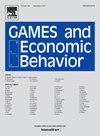网络中的定价与信息获取
IF 1
3区 经济学
Q3 ECONOMICS
引用次数: 0
摘要
本文研究了垄断者如何利用歧视性或统一定价方案从具有相关偏好的网络消费者那里战略性地获取信息。在统一定价条件下,通过迭代选择Katz-Bonacich中心性最高的消费者,可以在多项式时间内有效地解决最优信息获取问题。相比之下,在歧视性定价下,问题通常是NP-hard。然而,在典型的网络中,如完全二部网络、核心-外围网络和嵌套-分裂网络,最优目标群体可以用一种简单的方式来表征:垄断者只是优先考虑程度较高的消费者。对比分析表明,最优目标群体的规模随着信息成本的增加而减小,但在偏好相关性方面呈倒u型关系。允许垄断者获取信息在歧视性定价下总是会减少福利,而在统一定价下,这种影响并不一定是负面的。本文章由计算机程序翻译,如有差异,请以英文原文为准。
Pricing and information acquisition in networks
This paper investigates how a monopolist strategically acquires information from networked consumers with correlated preferences using discriminatory or uniform pricing schemes. Under uniform pricing, the optimal information acquisition problem can be efficiently solved in polynomial time by iteratively selecting consumers with the highest Katz-Bonacich centrality. By contrast, under discriminatory pricing, the problem is generally NP-hard. However, in typical networks, such as complete bipartite, core-periphery, and nested-split networks, the optimal targeted group can be characterized in a straightforward manner: the monopolist simply prioritizes consumers with higher degrees. A comparative analysis shows that the size of the optimal targeted group decreases with information cost but follows an inverted U-shape with respect to preference correlation. Allowing the monopolist to acquire information always reduces welfare under discriminatory pricing, whereas under uniform pricing, the impact is not necessarily negative.
求助全文
通过发布文献求助,成功后即可免费获取论文全文。
去求助
来源期刊

Games and Economic Behavior
ECONOMICS-
CiteScore
1.90
自引率
9.10%
发文量
148
期刊介绍:
Games and Economic Behavior facilitates cross-fertilization between theories and applications of game theoretic reasoning. It consistently attracts the best quality and most creative papers in interdisciplinary studies within the social, biological, and mathematical sciences. Most readers recognize it as the leading journal in game theory. Research Areas Include: • Game theory • Economics • Political science • Biology • Computer science • Mathematics • Psychology
 求助内容:
求助内容: 应助结果提醒方式:
应助结果提醒方式:


